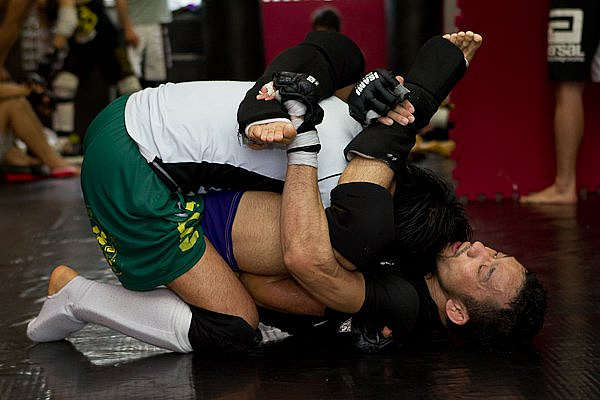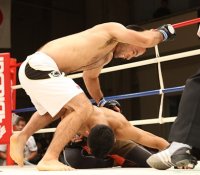In Search of the Real Tiger Mask
Zero to Hero
Tony Loiseleur Apr 30, 2011

Katsumura's rubber guard has given rise to the 'ninja choke.' |
Taro Irei/Sherdog.com
Katsumura debuted in Shooto in 1999 and, over the next five years, became one of its top talents. A 2004 loss to Marcos Galvao, however, saw Katsumura diverge from Shooto to compete in ZST.
“When I debuted in Shooto, I thought I wanted to be there for the rest of my career. I was one of the top-ranked Shootors then, but when I lost to Galvao, I began thinking that aiming for the top would be too difficult,” recalls Katsumura.
Advertisement
Likely due to ZST’s connection to Rings, Katsumura also competed in K-1 “Dynamite” and Hero’S in 2006 and 2007. K-1’s MMA efforts at the time were spearheaded by Rings founder Akira Maeda.
“I was hesitant [to fight in K-1] because it would be difficult
fighting bigger opponents,” says Katsumura, who at the time was a
featherweight stepping into lightweight competition. “But the
people around me encouraged me to participate because the fights
would be televised and everyone would see it.”
As expected, K-1’s media savvy and slick promos characterizing Katsumura as the child welfare worker who moonlighted as a professional fighter -- in essence, “The Real Tiger Mask”-- boosted his visibility. However, turmoil in his personal life and budding stardom made for a bad mix, leading Katsumura to resent the attention and ultimately alienating him from the sport. It is a time about which he offers little detail or explanation, speaking of it only in the broadest of terms.
“I lost twice in a row, but because I was on television, I got pretty popular. I didn’t feel like myself at the time, which is something I only realized much later. I didn’t really like what I had become,” he says, quietly and with apparent difficulty. “I wasn’t doing well in work or in my private life, so I decided to leave MMA for a little while.”
Katsumura’s hiatus lasted approximately one year, during which serious soul searching and the encouragement of his closest friends finally saw him found the Groundslam gym with ZST’s blessing and assistance.
“When I returned, the people that came to me during the time I was on television had all gone. The only people left were my friends who had known me for a long time. With their encouragement, I realized what was important to me, and I came back to start this gym,” says Katsumura. “I opened it as a way to show my appreciation and thanks to those that supported me. It wasn’t my intent to return to fighting, but after six months, the gym was doing well and ZST and Shooto asked me to fight.”
Birth of the Ninja Choke
In his November 2009 Shooto return, Katsumura defeated tough contender So Tazawa by brabo choke, immediately earning a shot against then 132-pound world champion Masakatsu Ueda -- a fundamentally solid wrestler with wins over current UFC fighter Takeya Mizugaki, Dream veteran Atsushi Yamamoto, Koetsu Okazaki and Eduardo Dantas. Katsumura’s rushed shot against the then Top 5 bantamweight seemed a harsh second turn in his Shooto homecoming. The fight was justified primarily on the drought of strong title contenders to Ueda and on Katsumura’s own grappling prowess, though pundits and fans predicted Ueda to neutralize him for a 15-minute decision victory.
Katsumura’s subsequent upset of Ueda to take the title at “The Way of Shooto 2” in March 2010 came with much surprise. Most shocking, however, was that he tapped Ueda in the second round with a modified brabo choke. While most fans point to Eddie Bravo for naming the creative finisher, given his history and penchant for naming everything he encounters, the responsibility in fact lies solely with Katsumura.
“Actually, I named it the ninja choke,” says Katsumura, with a proud grin.

T.
Irei
Darren Uyenoyama crushed Katsumura
last September.
“I wanted to find a way to be remembered when I went to fight in Lithuania [in 2006] and thought that the easiest way for people to know me as a Japanese fighter was to enter the ring dressed as a ninja."
"Before I left Japan, I told everyone that if my choke happened, I’d call it the ninja choke since that would be easy to remember, too,” says Katsumura.
Though the spectacular choke catapulted Katsumura back into relevance, his following title reign was unfortunately not without turbulence. One of the more confounding practices of Japanese MMA is the tendency to give reigning champions non-title fights between defenses. Shooto, while not strictly a promotion, is no exception to this practice, often putting the legitimacy of its champions uncomfortably into doubt whenever non-title bouts do not go swimmingly.
Such doubt was cast when, in the main event of “The Way of Shooto 5” in September, Dream and Strikeforce veteran Darren Uyenoyama brutally smashed Katsumura to a second-round technical knockout.
“I admit I wasn’t at my best, and my motivation wasn’t very high. Darren definitely studied me very well, however, and had the perfect game plan,” admits Katsumura.
A Ralph Gracie black belt, Uyenoyama’s jiu-jitsu was used less to put Katsumura on grappling notice than to escape his submission attempts and counter with punches on the ground. Katsumura latched on multiple heel hook attempts that left Uyenoyama sore in the knees after the fight, but the champion was still outgunned for nearly nine minutes. Uyenoyama’s only serious injury was to his hand, which he used to batter the champion to the stoppage.
“A few years back, I became friends with Joachim Hansen and Antonio Carvalho. I learned a lot of stuff from them but never got to incorporate it into a fight. The way I fought Katsumura is a way that I’ve trained but just never got to show until then,” says Uyenoyama.
Continue Reading » A Fitting Successor
Related Articles







